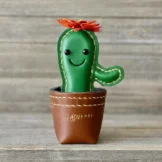In the vast world of succulents and cacti, one genus stands out for its captivating charm and diverse beauty: Gymnocalycium. Often overshadowed by more popular varieties like the moon cactus, Gymnocalyciums offer a treasure trove of unique species waiting to be discovered and appreciated. In this article, we embark on a journey to explore the hidden gems of Gymnocalycium cacti, shedding light on their common beauty and the allure that makes them a must-have for plant enthusiasts.

Table of Contents
ToggleConditions in Situ
Native to South America, Gymnocalycium cacti flourish in various regions like Argentina, Uruguay, Paraguay, Bolivia, and Brazil. Their natural homes span from arid deserts to open grasslands, showcasing their remarkable ability to adapt to diverse environments. While there are no strict rules for caring for every Gymnocalycium species, most are known for their hardiness, ease of care, and tolerance to light frosts. In cultivation, Gymnocalyciums prefer warm weather and ample sunlight, making them ideal choices for outdoor gardens or sunny windowsills. They are relatively easy to encourage to flower and generally stay small in size, making them suitable for container gardening or indoor display.
Common Gymnocalycium Cacti
With over 70 species in cultivation, according to some sources, and possibly even more as per others, Gymnocalyciums offer a plethora of options for collectors. From the naked covering of their flowers to their unique shapes and colors, there is no shortage of reasons to love Gymnocalyciums. Among the diverse array of Gymnocalycium species, some varieties are particularly notable for their distinctive traits and aesthetic allure. Within this group, two varieties are especially cherished by succulent enthusiasts.
1. Gymnocalycium baldianum: Chin Cactus
The Chin Cactus is celebrated for its endearing charm and prolific flowering, making it a beloved favorite among succulent collectors. This variety features compact, globular stems adorned with an array of colorful spines, creating a striking and visually appealing display. During the blooming season, the Chin Cactus erupts in a profusion of delicate, bell-shaped flowers, ranging from soft pinks to vibrant purples, adding a touch of elegance to any succulent collection.

2. Gymnocalycium Mihanovichii: The Moon Cactus
One of the most iconic Gymnocalycium species is Gymnocalycium mihanovichii, also known as the moon cactus. This species, native to South America, is popular for its striking appearance and unique mutations. Often grafted onto rootstock cacti like Hylocereus, the purple moon cactus showcases vibrant hues of red, orange, and yellow, captivating the attention of plant enthusiasts worldwide.

Caring for Gymnocalycium
While Gymnocalycium cacti are known for their resilience and ease of care, providing the right conditions is essential for their health and vitality. Here are some tips to ensure your Gymnocalycium thrives.
- Light: Gymnocalyciums prefer bright, indirect sunlight. Place them in a location with partial sun or use a 40% shade cloth to protect them from intense sunlight, especially during peak hours.
- Soil: To encourage healthy growth, plant your Gymnocalycium in a well-draining cactus mix that allows excess water to escape freely, preventing root rot. A mix of cactus soil or potting mix with sand, perlite, or pumice works well to provide adequate drainage and airflow around the roots.
- Watering: For optimal care, it’s essential to water Gymnocalycium deeply but infrequently. To prevent overwatering, let the soil dry completely between waterings, especially during spring and summer when your Gymnocalycium is actively growing. However, it’s crucial to adjust your watering routine during the winter dormancy months, reducing watering frequency to prevent rot and maintain the plant’s health.
- Temperature and Humidity: Gymnocalycium thrive in warm temperatures, ideally ranging between 18°C and 24°C (65°F and 75°F). They prefer environments with low humidity, so high humidity levels are unnecessary. To ensure their well-being, it’s crucial to protect them from frost, shielding them from freezing temperatures.
- Fertilization: To promote healthy growth, it’s advisable to feed your Gymnocalycium during its active growth phases in spring and summer. Feed your Gymnocalycium with a diluted balanced fertilizer during active growth. However, refrain from fertilizing your Gymnocalycium during its winter dormancy period, allowing it to rest without additional nutrients.
- Pot Size: Choose a pot that is only slightly larger than the plant’s main stem to prevent excess moisture retention in the soil. Your Gymnocalycium might need a new pot every two to three years, or if its roots become crowded in the current container.
Conclusion
Gymnocalycium cacti offer a wealth of beauty and diversity that deserves recognition and appreciation. From their unique shapes and colors to their resilience and ease of care, Gymnocalyciums have earned their place as beloved additions to any plant collection. By exploring the hidden gems within this genus, enthusiasts can discover new favorites and expand their appreciation for these fascinating cacti. So let’s embrace the beauty of Gymnocalyciums and uncover the uncommon treasures they have to offer.

Pingback: What is a Cactus – Definition & Meaning